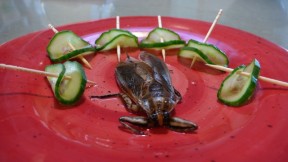
Hey East Coast, the United Nations has a solution to your cicada situation: eat them. The UN’s Food and Agriculture Organization has a new report out this week about the benefits of eating insects. The authors point out that the global human population is growing, but space available for farming isn’t. Insects require less land and water than, say, cows or chickens, and compared to the over-fished oceans, they’re a relatively untapped resource. Plus, they’re a good source of protein. Lots of cultures already include bugs in their cooking. But will Americans ever eat meal worm tacos or cricket stir fry en masse?
“Convincing everyone to eat insects will be a challenge, but there are many ‘faceless’ and indirect ways of adding insect protein to our diet,” said Brian Fisher, curator of entomology for the California Academy of Sciences in San Francisco. “The obvious starting point is not fried grasshoppers for lunch, but using insects to feed farmed fish, chickens, pigs and cows. But soon, I am convinced instead of that prized meal of lobster, we will all soon be wishing to dine on tasty insects.”
And, really, how different is a crustacean from an insect?
The UN estimates that about two billion people already include insects in their diet. Sure, it’s less common here, but for the hungry and the intrepid, there’s chef and artist Monica Martinez’s Don Bugito, a popular San Francisco food truck (and KQED’s QUEST featured in a TV segment about eating insects). She serves things like blue corn tortilla tacos stuffed with wax moth larvae, and gave high marks to the report, in which she’s featured.
“Edible insects are not only a dietary solution for developing countries, they are also a great ecological and sustainable food resource for Western countries which lack diversity in their diets due to the abundance of processed foods,” Martinez said. “This new FAO publication is a great resource to begin understanding the power of a diverse diet.”